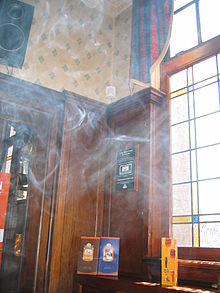
Back تدخين سلبي Arabic পরোক্ষ ধূমপান Bengali/Bangla Fumador passiu Catalan Pasivní kouření Czech Passiv rygning Danish Passivrauchen German Παθητικό κάπνισμα Greek Pasiva fumado Esperanto Fumador pasivo Spanish آلاینده هوای غیرفعال Persian

Passive smoking is the inhalation of tobacco smoke, called passive smoke, secondhand smoke (SHS) or environmental tobacco smoke (ETS), by individuals other than the active smoker. It occurs when tobacco smoke diffuses into the surrounding atmosphere as an aerosol pollutant, which leads to its inhalation by nearby bystanders within the same environment. Exposure to secondhand tobacco smoke causes many of the same health effects caused by active smoking,[1][2] although at a lower prevalence due to the reduced concentration of smoke that enters the airway.
According to a WHO report published in 2023, more than 1.3 million deaths are attributed to passive smoking worldwide every year.[3] The health risks of secondhand smoke are a matter of scientific consensus,[4][5][6] and have been a major motivation for smoking bans in workplaces and indoor venues, including restaurants, bars and night clubs, as well as some open public spaces.[7]
Concerns around secondhand smoke have played a central role in the debate over the harms and regulation of tobacco products. Since the early 1970s, the tobacco industry has viewed public concern over secondhand smoke as a serious threat to its business interests.[8] Despite the industry's awareness of the harms of secondhand smoke as early as the 1980s, the tobacco industry coordinated a scientific controversy with the purpose of stopping regulation of their products.[4]: 1242 [6]
- ^ "The Health Consequences of Involuntary Exposure to Tobacco Smoke: A Report of the Surgeon General" (PDF). Surgeon General of the United States. 2006-06-27. Archived from the original (PDF) on 2019-02-26. Retrieved 2012-07-24.
Secondhand smoke causes premature death and disease in children and in adults who do not smoke
- ^ IARC 2004 "There is sufficient evidence that involuntary smoking (exposure to secondhand or 'environmental' tobacco smoke) causes lung cancer in humans"
- ^ "Tobacco". www.who.int. Retrieved 2024-02-24.
- ^ a b Cite error: The named reference
kesslerwas invoked but never defined (see the help page). - ^ Samet JM (2008). "Secondhand smoke: facts and lies". Salud Pública de México. 50 (5): 428–34. doi:10.1590/S0036-36342008000500016. PMID 18852940.
- ^ a b Tong, Elisa K.; Glantz, Stanton A. (16 October 2007). "Tobacco Industry Efforts Undermining Evidence Linking Secondhand Smoke With Cardiovascular Disease". Circulation. 116 (16): 1845–1854. doi:10.1161/CIRCULATIONAHA.107.715888. PMID 17938301. S2CID 4021497.
- ^ "CDC - Fact Sheet - Smoke-Free Policies Reduce Smoking - Smoking & Tobacco Use". Smoking and Tobacco Use. Retrieved 2015-04-24.
- ^ Diethelm, Pascal; McKee, Martin (2006). Lifting the smokescreen: tobacco industry strategy to defeat smoke free policies and legislation (PDF). p. 5. ISBN 978-1-904097-57-0. OCLC 891398524.
The industry quickly realised that, if it wanted to continue to prosper, it became vital that research did not demonstrate that tobacco smoke was a dangerous community air pollutant. This requirement has been the central pillar of its passive smoking policy from the early 1970s to the present day